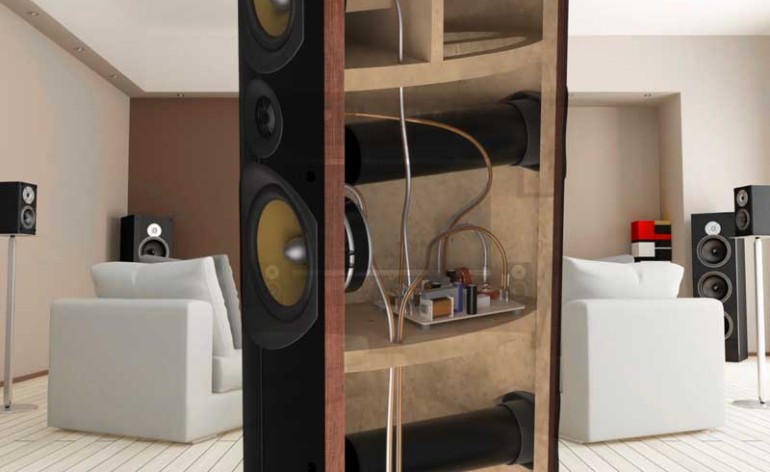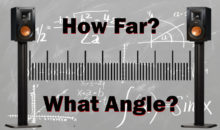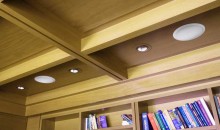Understanding Speaker Specs
There are a lot of specifications when it comes to loudspeakers, and understanding speaker specs can be a real pain if you’re sifting through data you don’t fully grasp. Add to that the fact that manufacturers want to tout features and specs that may not be as important as others, and you’ve got quite the specifications minefield to navigate. We always recommend auditioning a loudspeaker whenever possible, but we also review them so that we can give you a leg up on what products perform better than others. Still, the specifications game is one way you can at least whittle down your list to something more manageable—giving you a starting point and a shorter group of products from which to decide.
In no particular order, here are some of the more common speaker specs you’ll want to understand when you’re shopping:
Power Handling
This is the maximum nominal (consistent) amount of wattage the speakers can handle from an amplifier. This spec is all but useless unless you’re trying to power a set of cubed speakers with separates, or attempting to run a pair of flagship towers with a $249 entry-level AV receiver. Rather than focus on this, concentrate on matching an amplifier or AV receiver to a speaker that is in the same ballpark in terms of price. Then, look to some other specifications that mean more to a speaker’s ability to output audio in your room (such as sensitivity).
Sensitivity
When you see a sensitivity rating, it is always written as a factor of SPL output from a particular distance. This is a rating that tells you what the output of a speaker is when fed a 1kHz signal (sine wave) at exactly 1 Watt (2.83V at 8 ohms) and measured on-axis from 1 meter away. This is a great number because it tells you how “efficiently” the speaker uses amplifier power. In a sense, you could call this how “loud” the speaker is, but that’s not entirely true since a less efficient speaker might be able to take more power before distorting.
To give you an idea of how much this matters, consider that the way we perceive something as being “twice as loud” means that it has increased by 10 dB SPL. If one speaker has a rating of 84 dB SPL @ 1W/m and another has a sensitivity of 94 dB SPL @ 1W/m then it will take twice the amplifier power to bring the first speaker to the same volume as the second. That’s an amazing difference that will mean a lot when you’re trying to fill a larger room or playback music at much louder volumes.
Editor’s Note: Manufacturers will often play with the sensitivity to make their speakers seem more efficient. A 1w/1m rating for an 8-ohm speaker is not equivalent to a 1w/1m rating for a 4-ohm speaker. If they list 2.83 volts instead of 1 watt, look at the impedance rating (see below). If one is a 4 or 6-ohm speaker and the other is an 8-ohm speaker, those ratings cannot be compared directly.
Impedance
A speaker’s impedance rating is always given as a single number—which is a bit deceiving. Every loudspeaker’s impedance curve is just that—a curve. There are frequencies that drop the impedance down and require more power from the amplifier. The bottom line is that impedance is the resistance or “load” the loudspeaker presents to the supplied power. A majority of speakers are rated at 8-ohms. That is a nominal, or averaged, impedance specification and it means the speaker can be driven by just about anything more powerful than a 9V battery. It may not be loud or efficient, but it will work. In comparison, 4-ohm speakers may require more power and a better quality amplifier if you intend to play them loudly or fill a large room with audio. There’s also the chance that playing a 4-ohm speaker on a lower-cost amplifier or receiver could, after a sustained period of time, actually ruin the amplifier. Think of it like this: How far would you get powering a laptop off a battery that had half the amount of voltage required? It may power up, but very quickly that power supply will start to smoke. Match the amp or receiver to the speaker and you’ll be much better off.
Editor’s Note: As mentioned, the impedance is a curve. In some speakers, there will be wild fluctuations that will not be indicated by the rating. When possible, look for a “minimum impedance” rating as well. An extremely low number (anything under 4 ohms) may indicate that you’ll need beefy amplification. If you see a 2-ohm minimum, definitely look into buying a dedicated amplifier.
The “Room” Factor
Now that you’re an expert on understanding speaker specs, you’ll want to learn about one more critical factor: Your listening room or home theater. It’s your room that will determine the kind of amplifier power, sensitivity, and overall system you’ll need. A small room requires a remarkably small amount of power to fill – particularly with a 5.1 system. With all of those speakers (bookshelf speakers would be fine here) and only 8-10 feet between them and the center of the room, you’re going to need only a small amount of power to hear your movies and music in all their glory. And, sure, you can up the ante on quality and spend more—but in terms of raw power, a small amplifier around 80-100 Watts will likely do just fine.
When we get into larger rooms, however, or rooms that require more power due to lack of reflectivity (we call these “dampened” or “dead” rooms) then you’ll want to look at more efficient speakers, better amplification, and more power overall. The last thing you want to do is find yourself maxing out the amplifier or AV receiver to near-top volumes in order to fill a room. That’s where distortion is going to come into play, ruining the clarity of your audio and bringing audio ruin to your system. Conversely, a room that is quite reverberant will need some work before it can handle a system that can play louder. If you don’t make modifications, then you’re audio will be muddy and dialogue can be difficult to understand.
Conclusion
The rest of the specs in a loudspeaker really don’t bear much on whether they’re good or even preferred in your room. The only exceptions are things that help them interface with your equipment. This could include bi-wirability or even features to help in your required placement. Some speakers, for example, have adjustments for boosting or cutting the top end response of the tweeter to help for room acoustics and compromised placement. Still other speakers will have a mid-bass emphasis control to deal with locations close to a wall (which tends to accentuate the bottom end due to some very specific acoustic principles).
As always, choose your speakers wisely. Of all of your components, they really don’t ever go out of style and should last you a very long time. You can always upgrade them, but it won’t be because some newfangled technology came into play that stopped them from working or made them obsolete.







Hi I am looking at buying 4 speakers that are 8ohm each my amp says front a or b 6ohms min speaker , front a+b 12 ohms min speaker will the speakers be ok for this amp . cheers Frank
need the definitions of: 1. Versin (our Bose speaker is 3.0 + EDR (need EDR definition also. 2. Koleer (our speaker shows 10 M/5 w.
Thanks much
To increase SPL by 10 dB requires TEN TIMES the power in Watts not “twice the power”
As a reference: https://jlaudio.zendesk.com/hc/en-us/articles/217201737-Doubling-Power-vs-Doubling-Output
Good article, but there is one very significant error. To increase a speaker’s SPL by 10 decibels takes 10 times the power, not twice the power. Twice the power would only give a boost of 3 decibels – noticeable, but not that much